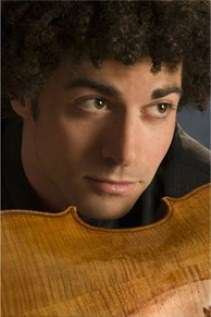|
Back
Secrets Of A Winter Night New York
SubCulture, 45 Bleeker Street
02/02/2015 -
Bohuslav Martinů: Three Madrigals for Violin and Viola, H. 313
György Kurtág: Selections from Signs, Games and Messages
Antonín Dvorák: Miniatures for Two Violins and Viola, Opus 75A
György Ligeti: Hora Lunga from Sonata for Solo Viola
Zoltán Kodály: Serenade for Two Violins and Viola, Opus 12
Miriam Fried (Violin), Kobi Malkin (Violin), Hsin-Yun Huang (Viola) 
Huang H.-Y., M. Fried (© SubCulture)
Perhaps the only way to melt down the slush, icy-rain-snow and wrath of the Unforgiving Meteorological Gods would be three treble instruments, placating the deities with exotic modes, lyrical melodies, and the glories of Slavic/Magyar major thirds.
In other words (rather, other music), SubCulture continued its “Concerts for the Adventurous”, this time with post-Dvorák Eastern melodies, for the rare combination of two violins and one viola. Two of the artists are very well known–Miriam Fried and Hsin-Yun Huang. But the third, violinist Kobi Malkin, had his own solo in an evening which embraced both solos and ensembles.
The first solo came from Ms. Fried, playing the only living composer, György Kurtág, whose miniatures have become increasingly startling. They seem so simple, yet hide such paradoxes, tantalizing secrets which can never be deciphered, except by the artist.
Ms. Fried began with a Bach homage–nothing complex, but the ideal conversational contrasts of registers which seemed to be both Bach and non-Bach. This was followed by a square-danced Perpetuum Mobile, where the composer seemed to be having pure fun. The fourth of Signs, Games and Measures, “In Nomine–all’ongherese” was the longest and most heartfelt. This was neither sign nor game, but a lamenting message, played with the emotional stops.
Of course all “official” Hungarian music seems doleful and pessimistic, with their National Anthem a virtual soap-operatic wailing. When Mr. Kurtág writes his homage, the result may be dark, but the performance transcends mere human emotion. And Ms. Fried caught that unaccountable Kurtág transcendence.
As for violist Hsin-Yun Huang, how simple it would be to say that she is a “regular” in New York concerts. Nothing is regular in her instrument or her playing. She was as entrancing in a work by Stephen Mackay some years ago as in the Schoenberg String Quartet, that 55-minute work which kept SubCulture audiences breathless last month.
What was irregular here in her single solo piece was that she needed only a single string, the low C string, for the “Slow Dance” from Ligeti’s Solo Sonata. Superficially, she was playing a fairly simple diatonic tune on this string. But Ligeti was never ordinary. Here, his artist had to create exact notes not only fractionally but with precise fractions above or below their normal sounds.
How difficult this would be for the artist is obvious, for Ms. Huang was practicing it for over a year. In fact, the first time, a note sounded...er...wrong. After that each “wrong” note was like a tiny, almost enjoyable shock. Ms. Huang, with seeming ease, would give us that miniature jolt, like an unexpected tickle, until Ligeti finished with another surprise. On that same C string, Ms. Huang opened up the harmonics to the very highest notes, four octaves higher than the low notes…than drifting away to its own unheard pantheon.

K. Malkin (© Susan Wilson)
It was somewhat revolutionary that Dvorák had to be persuaded by Brahms to write music of his own country, at a time when everybody wanted to “write German”. Obviously he took to it with delight, as was the delight of hearing Kobi Malkin as First Violin in the Dvorák Miniatures. I had never heard them before, but “miniature” is a poor name, as each of the four movements are substantial in themselves. Ending the warm, lyrical, euphoric openings with a finale “elegy” showed that even this most extrovert composer had his own secrets.
Mr. Malkin’s own solos here were elegantly done. But it was the ensemble itself, trading timbres and colors, both rustic and sophisticated, which gave the piece such joy.
The opening and closing works offered that unfettered elation which thawed the horrors of the wintry outside. Martinů did have his personal problems, but they rarely erupted with his string facility. The zesty playing of Fried and Huang, with Martinů’s idiosyncratic style seemed to open SubCulture itself.
Yet it was the final Kodály Serenade that was most enigmatic. His works for solo and ensemble strings are, I feel, his most profound works. Yet his variations on the Hungarian “Peacock” song shows his fascination with folklore.
Here, the conversations of instruments was given enough play. Yet in the second movement, Lento, ma non troppo, we had the most electrifying surprise. Nobody would ever confuse Kodály with his colleague-friend Bartók. But in this movement, Kodály came as close to Bartók’s familiar “night-music” as anything he ever composed.
These were sounds of birds and breaths, Ms. Huang’s drone under pizzicato violins, then the darkness again. All of this before a lengthy, but never uninspired Vivo finale.
I confess that trudging through the East Village to SubCulture was an Augean effort, sinking into slush, sliding into puddles, slipping on the dark ice in a dark night. After the music of these Czech and Hungarian masters, the return over these same treacherous streets was transported into a jump and a romp. And while Messrs Fried, Huang and Malkin was anything but pedestrian, they and their music gave this pedestrian a boundless delight.
Harry Rolnick
|